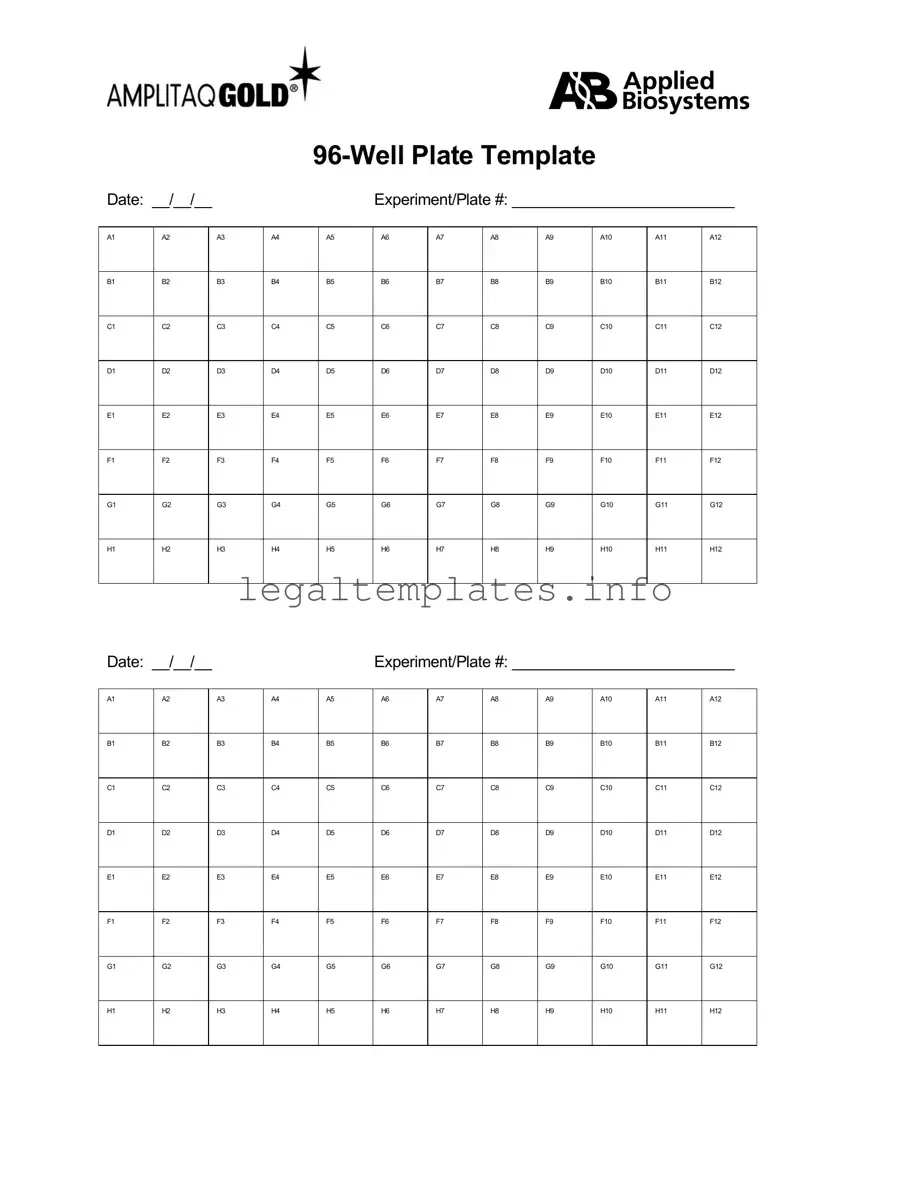The 96 Well Plate Template is akin to the 384 Well Plate Template in its primary function of organizing experimental samples. Both templates are designed for laboratory use, facilitating the tracking and management of multiple samples simultaneously. Where the 96 Well Plate Template accommodates 96 samples, the 384 Well Plate Template offers space for a denser configuration of 384 samples, allowing for more extensive experimentation within a compact space. This scalability is crucial for experiments that require varying sample sizes or high-throughput screening.
Similarly, the Sample Inventory Sheet shares a common purpose with the 96 Well Plate Template by providing a systematic method for logging and tracking samples. However, the Sample Inventory Sheet is utilized more broadly across different fields and types of research, beyond the confines of a laboratory's well plates. It typically includes details such as sample ID, location, quantity, and condition, making it a versatile tool for managing a wide array of physical samples.
The Laboratory Notebook Page closely resembles the 96 Well Plate Template in its role as a record-keeping tool for experiments. Both documents are essential for documenting experimental designs, procedures, observations, and results. The Laboratory Notebook Page, however, is more narrative and descriptive, allowing researchers to write detailed entries about their work progress, whereas the 96 Well Plate Template is more structured and focused on sample organization.
The Chain of Custody Form, often used in forensic science, shares similarities with the 96 Well Plate Template in ensuring the traceability of samples. Both documents contribute to maintaining the integrity of samples by documenting their handling and storage history. While the 96 Well Plate Template tracks samples in a laboratory setting, the Chain of Custody Form is critical in legal contexts, providing a detailed record that helps establish evidence admissibility in court proceedings.
The Medication Administration Record (MAR) parallels the 96 Well Plate Template through its meticulous tracking of medication given to patients in healthcare settings. Like the 96 Well Plate Template, which ensures samples are accurately managed for experimental validity, the MAR ensures patient safety and treatment effectiveness by recording the time, dose, and type of medication administered, highlighting the importance of accurate tracking systems in both health care and research.
The Chemical Inventory List bears resemblances to the 96 Well Plate Template by serving as a structured record for managing chemical substances within a laboratory. Both documents help in organizing and documenting essential items — one for chemicals and the other for sample wells. The Chemical Inventory List is crucial for safety and regulatory compliance, ensuring that all chemicals are accounted for, similar to how the 96 Well Plate Template helps in the reliable execution of experiments.
The Quality Control Checklist is another document similar to the 96 Well Plate Template, as it is used to maintain and verify standards within operational procedures. In the context of laboratory experiments, both documents assist in ensuring that the processes follow specified guidelines to produce valid and reliable results. The Quality Control Checklist, however, focuses broadly on operational standards, whereas the 96 Well Plate Template is specific to sample arrangement and tracking.
The Clinical Trial Consent Form and the 96 Well Plate Template serve regulatory purposes, albeit in different contexts. The consent form is a necessary document for ethical compliance in human research, ensuring participants are informed about the study they're partaking in. The 96 Well Plate Template, while not dealing directly with human subjects, supports the integrity of the research process by organizing samples in a manner that mitigates errors and promotes reproducibility.
The Laboratory Requisition Form, needed to request laboratory tests or procedures, shares a functional similarity with the 96 Well Plate Template by facilitating the processing and handling of samples. While the requisition form is used to communicate between healthcare providers and laboratory personnel, specifying tests to be performed on patient samples, the 96 Well Plate Template organizes those samples on a micro-scale within the lab, ensuring that each is correctly identified and processed according to the study design.
Last but not least, the Data Collection Sheet is akin to the 96 Well Plate Template in its fundamental role of systematically capturing information. In research and data analysis, both documents are indispensable for structuring data in an easily accessible format. The Data Collection Sheet is adaptable to various contexts, from surveys to observational studies, whereas the 96 Well Plate Template is specialized for laboratory sample management, highlighting the critical task of organizing data across different research disciplines.

